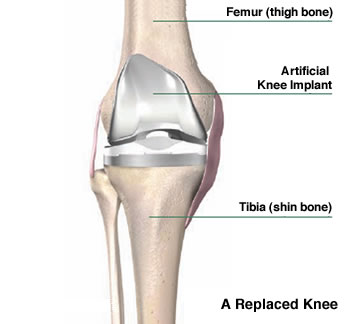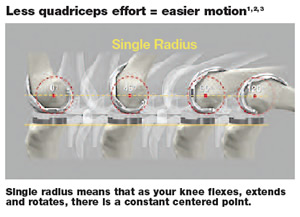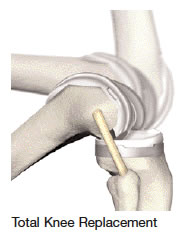Are You Considering Knee Replacement Surgery?
Each patient is unique, but generally candidates for knee replacement surgery have:
- Pain severe enough to restrict not only work and recreation, but also the routine activities of daily living
- Pain that is not relieved by more conservative methods of treatment, such as reduced activity, medication or physical therapy
- Significant joint stiffness and loss of mobility
- X-rays that show advanced arthritis or other degenerative problems
The National Institutes of Health (NIH) has concluded that knee replacement surgery is “a safe and cost-effective treatment for alleviating pain and restoring function in patients who do not respond to non-surgical therapies.”1 According to the American Academy of Orthopaedic Surgeons, knee replacement procedures have resulted in significant restoration of function and reduction of pain in about 90% of patients.2 As you read,make a note of anything you don’t understand. Your doctor will be happy to answer your questions so that you’ll feel comfortable and confident with your chosen treatment plan.
References:
1. National Institutes of Health Consensus Development Conference Statement: Total Knee Replacement 12/10/03.
2. AAOS website, https://orthoinfo.aaos. org/topic.cfm?topic=A00385, accessed April 2011.
 Knee Basics: What You Need to Know
Knee Basics: What You Need to Know
Knee Anatomy and Function
The knee is the largest joint in the body and is central to nearly every routine activity. The knee joint is formed by the ends of 3 bones: the lower end of the thigh bone (femur), the upper end of the shin bone (tibia), and the kneecap (patella). Thick, tough tissue bands called ligaments connect the bones and stabilize the joint. A smooth, plastic like lining called cartilage covers the ends of the bones and prevents them from rubbing against each other, allowing for flexible and nearly frictionless movement. Cartilage also serves as a shock absorber, cushioning the bones from the forces between them. Finally, a soft tissue called synovium lines the joint and produces a lubricating fluid that reduces friction and wear.
Arthritis: The Leading Cause of Knee Pain
One of the most common causes of knee pain and loss of mobility is the wearing away of the joint’s cartilage lining. When this happens, the bones rub against each other, causing significant pain and swelling — a condition known as osteoarthritis. Trauma or direct injury to the knee can also cause osteoarthritis. Without cartilage there is no shock absorption between the bones in the joint. This allows stress to build up in the bones and contributes to pain.
 Knee Replacement
Knee Replacement
Knee replacement is a surgical procedure — performed in the U.S. since the 1960s — in which a diseased or damaged joint is replaced with an artificial joint called a prosthesis.Made of metal alloys and high-grade plastics (to better match the function of bone and cartilage, respectively), the prosthesis is designed to move just like a healthy human joint. Over the years, knee replacement techniques and instrumentation have undergone countless improvements. Today, knee replacement is one of the safest and most successful types of major surgery; in about 90% of cases it is complication-free and results in significant pain relief and restoration of mobility.1
References:
1. AAOS website, https://orthoinfo.aaos. org/topic.cfm?topic=A00385, accessed April 2011.
Knee Implants That Promote Easier Motion1,2,3
 Stryker knee replacements are different than traditional knee replacements because they are designed to work with the body to promote easier motion,1,2,3 and a study has shown a more rapid return to functional activities after surgery.2 This is due to the single radius design of the knee implant. Single radius means that as your knee flexes, the radius is the same, similar to a circle, requiring less effort from your quadriceps muscle.1,4,6
Stryker knee replacements are different than traditional knee replacements because they are designed to work with the body to promote easier motion,1,2,3 and a study has shown a more rapid return to functional activities after surgery.2 This is due to the single radius design of the knee implant. Single radius means that as your knee flexes, the radius is the same, similar to a circle, requiring less effort from your quadriceps muscle.1,4,6
Because the thigh muscle (the quadriceps) is attached to your knee, it is unavoidably involved in the surgery. Therefore, the quadriceps muscle can become a source of discomfort or pain during your recovery period. The quadriceps muscle plays an important role in your ability to move your legs so it also has a major impact on your recovery and how quickly you can get back to living your life.2
Knee implants designed to last longer5
Several factors influence how long an implant will continue to perform. Stryker knees are designed to resist wear in many ways — they use advanced bearing surfaces; they’re balanced to help avoid excessive stress in any one spot; and, they’re sized to better fit your personal anatomy. X3 Advanced Bearing Technology has demonstrated up to 96% decrease in wear in laboratory testing compared to competitive premium bearing technologies.5
References:
1. Ostermeier, S; Stukenborg-Colsman, C, Hannover Medical School (MHH) Hannover, Germany ‘Quadriceps force after TKA — a comparison between single and multiple radius designs,” Poster No. 2060 • 56th Annual Meeting of the Orthopaedic Research Society.
2. Harwin, S.F., Hitt, K, Greene, K.A. Early Experience with a New Total Knee Implant: Maximizing Range of Motion and Function with Gender-Specific Sizing Orthopedic Surgery, Surgical Technology International, XVI. pgs 1-7.
3. Greene, K.A. Range of Motion: Early Results from the Triathlon® Knee System, Stryker Literature Ref #LSA56., 2005.
4.Wang, H., Simpson, K.J., Ferrary M.S., Chamnongkich, S., Kinsey, T, Mahoney, O.M., Biomechanical Differences Exhibited During Sit- To-Stand Between Total Knee Arthroplasty Designs of Varying Radii, JOA, Vol. 21, No. 8, 2006.
5. Stryker Orthopaedics Test Report: 06-013.
6. The effect of total knee arthroplasty design on extensor mechanism function, JOA, Vol. 17, Issue 4, June 2002, pp. 416-421.
What Typically Happens During the Surgery
 To begin the surgery, the surgeon will make an incision on the front of your knee, cutting through the tissue surrounding the muscles and bone. The kneecap, or patella, is rotated to the outside of the knee, to help your doctor see the area where the implant will be placed. The surgeon will use special cutting instruments to measure and make precise cuts of the bone. The end of the femur (thigh bone) is cut into a shape that matches the corresponding surface of the metal femoral component. The femoral component is then placed on the end of the femur.
To begin the surgery, the surgeon will make an incision on the front of your knee, cutting through the tissue surrounding the muscles and bone. The kneecap, or patella, is rotated to the outside of the knee, to help your doctor see the area where the implant will be placed. The surgeon will use special cutting instruments to measure and make precise cuts of the bone. The end of the femur (thigh bone) is cut into a shape that matches the corresponding surface of the metal femoral component. The femoral component is then placed on the end of the femur.
The tibia (shin bone) is prepared with a flat cut on the top. The exposed end of the bone is sized to fit the metal and plastic tibial components. The metal tibial component is inserted into the bone. Then a plastic insert is snapped into the tibial component. The femoral component will slide on this plastic as you bend your knee.
If needed, the patella (kneecap) is also cut flat, and fitted with a plastic patellar component. Bone cement may be used to help secure the implants onto your bone. Your surgeon will conduct several tests during the surgery to ensure the correct sized components are used to help you regain good balance and motion in your knee. Your surgeon will then close the wound in layers with stitches and/or staples.
Risks Associated with Knee Replacement
But as good as the results can be, knee replacement is major surgery, and as such, there are certain risks and expectations that must be recognized. As with any major surgical procedure, patients who undergo total joint replacement are at risk for certain complications, the vast majority of which can be successfully avoided or treated. In fact, the complication rate following joint replacement surgery is very low. Serious complications, such as joint infection, occur in less than 2% of patients.1 Other possible complications include blood clots and lung congestion, or pneumonia. Talk to your doctor for a complete assessment of the potential risks.
Life After Knee Replacement
The vast majority of individuals who have joint replacement surgery experience a dramatic reduction in joint pain and a significant improvement in their ability to participate in the activities of daily living. However, joint replacement surgery will not allow you to do more than you could before joint problems developed. Your doctor will recommend the most appropriate level of activity following joint replacement surgery.
Don’t Let Knee Pain Slow You Down
Don’t let severe knee pain limit your activities. If you haven’t experienced adequate relief with medication and other conservative treatments, joint replacement may provide the pain relief you long for and enable you to return to your favorite activities. Remember, even if your doctor recommends knee replacement for you, it is still up to you to make the final decision. The ultimate goal is for you to be as comfortable as possible with your choice — and that always means making the best decision based on your own individual needs.
For more information visit AboutStryker.com and contact your doctor.
References:
1. Hanssen, A.D., et al., ‘Evaluation and Treatment of Infection at the Site of a Total Hip or Knee Arthroplasty,” JBJS, Vol.80-A, No. 6, June 1998, pp. 910-922.